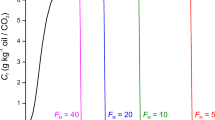Abstract
The influence of the two contact modes, percolation and immersion, during the extraction of oilseeds by means of a solvent are presented. Experiments were performed in lab-scale equipment with soybean flakes, arranged in beds that reproduce these two contact modes. The extractions were carried out with hexane at constant temperature. To simulate the performance of shallow-and deep-bed extractors, two different bed height/diameter ratios were used. The experimental results are explained in terms of the basic transfer phenomena that occur during extraction. These phenomena are addressed to develop a mathematical model, which is used to simulate extraction under both contact modes. The immersion scheme yielded greater efficiency than the percolation mode to extract soybean flakes for the two bed height/diameter ratios studied. The mathematical model predicts very well the experimental findings. It also predicts the solvent retained by the solid mass after extracting the oil.
Similar content being viewed by others
References
Lajara, J., Solvent Extraction of Oil from Oilsseds: The Real Basics, in Proceedings of the World Conference on Edible Fats and Oils Processing, AOCS Press, Champaign, 1989, pp. 49–55.
Christensen, P., Solvent Extraction: Recent Developments, J. Am. Oil Chem. Soc. 60:166–167 (1983).
Prabhudesai, R., Leaching, in Handbook of Separation Techniques for Chemical Engineers, edited by P. Schweitzer, McGraw-Hill, New York, 1997, pp. 5.3–5.31.
Pavlik, R., and T. Kemper, Benefits in Utilizing the Extruder, inform 3:201–204 (1990).
Kemper, T., Extraction Principles and Extractor Design, in Technology and Solvents for Extracting Oilseeds and Nonpetroleum Oils, edited by P. Wan and P. Wakelyn, AOCS Press, Champaign, 1997, pp. 137–141.
Rice, R., Approximate Solutions for Batch, Packed Tube and Radial Flow Adsorbers, Chem. Eng. Sci. 37:83–91 (1982).
Crank, J., The Mathematics of Diffusion, Oxford University Press, London, 1970, pp. 52–91.
Desai, M., and H. Schwartzberg, Mathematical Modeling of Leaching Processes, in Food Processing Systems, edited by P. Linko, Y. Malkki, J. Olkku, and J. Larnikari, Applied Science Press, London, 1980, pp. 86–91.
Flores de Hoyos, S., and H. Schwartzberg, Modeling of Counterucurrent, Crossflow, Solid-Liquid Extractors and Experimental Verification, in Food Engineering and Process Application, edited by L. Maguer and J. Jelen, Elsevier Applied Science, Essex, 1987, pp. 413–421.
Majumdar, G., A. Samanta, and S. Sengupta, Modeling Solvent Extraction of Vegetable Oil in a Packed Bed, J. Am. Oil Chem. Soc. 72:971–974 (1995).
Pramparo, M., M. Martinello, and M. Mattea, Design and Simulation of a Continuous Extractor, in Proceeding of ler. Congreso de Ingeniería de Procesos del Mercosur, Sapienza Impresiones, Bahía Blanca, Argentina, 1997, pp. 127–128.
Karnofsky, G., Design of Oilseed Extractors, J. Am. Oil Chem. Soc. 63:1011–1014 (1986).
Zeitsch, K., Centrifugal Filtration, in Solid-Liquid Separation, edited by L. Svarovsky, Butterworth, London, 1990, pp. 476–532.
Constantinides, A., and N. Mostoufi, Numerical Methods for Chemical Engineers with MatLab Applications, Prentice Hall, Upper Saddle River, NJ, 1999.
Reid, R., J. Prausnitz, and B. Poling, The Properties of Gases and Liquids, 4th edn., McGraw-Hill, New York, 1987, pp. 388–656.
Adamson, A., Physical Chemistry of Surfaces, 4th edn., John Wiley & Sons, New York, 1982, pp. 4–49.
Sherwood, T., R. Pigford, and C. Wilke, Mass Transfer, McGraw-Hill, New York, 1975, pp. 9–157.
Kärger, J., and Y. Ruthven, Diffusion in Zeolites and other Microporous Solids, John Wiley & Sons, New York, 1992, pp. 232–245.
American Oil Chemists' Society, Official and Recommended Practices of the American Oil Chemists' Society, 4th edn., AOCS Press, Champaign, 1994.
Lozano, J., E. Rotstein, and M. Urbicain, Total Porosity and Open-pore Porosity in the Dyring of Fruits, J. Food Sci. 45:1403–1407 (1980).
Montgomery, D., Design and Analysis of Experiments, 3rd edn., John Wiley & Sons, New York, 1991, pp. 38–42.
Author information
Authors and Affiliations
Corresponding author
About this article
Cite this article
Pramparo, M., Gregory, S. & Mattea, M. Immersion vs. percolation in the extraction of oil from oleaginous seeds. J Amer Oil Chem Soc 79, 955–960 (2002). https://doi.org/10.1007/s11746-002-0586-3
Received:
Accepted:
Issue Date:
DOI: https://doi.org/10.1007/s11746-002-0586-3




